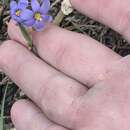Comments
provided by eFloras
K. L. Hornberger (1987, 1991) and D. S. Correll and M. C. Johnston (1970) considered Sisyrinchium texanum to be conspecific with S. sagittiferum (Correll and Johnston called it a “hybrid form”). E. P. Bicknell, however, described S. sagittiferum as being unbranched, and the single (poor) type specimen (Riddell s.n., NY) agrees. We follow Bicknell’s original concept of a single-stemmed S. sagittiferum. Sisyrinchium texanum, being branched, is not considered a synonym here.
- license
- cc-by-nc-sa-3.0
- copyright
- Missouri Botanical Garden, 4344 Shaw Boulevard, St. Louis, MO, 63110 USA
Description
provided by eFloras
Herbs, perennial, cespitose, dark brown to reddish brown or brownish olive when dry, to 4.5 dm, not glaucous. Stems simple, 0.9–2.1 mm wide, glabrous, margins usually entire, usually not hyaline, similar in color and texture to stem body. Leaf blades glabrous, bases becoming fibrous, persisting in tufts. Inflorescences borne singly; spathes often purplish brown, glabrous, keels entire; outer 15–33 mm, 6.2–13 mm longer than inner, basally connate 1–2.7 mm, tapering evenly towards apex; inner with keel gibbous basally, hyaline margins 0.5–0.6 mm wide, apex rounded or truncate, somewhat erose, usually extending beyond green apex as 2 lobes. Flowers: tepals blue to bluish violet, bases yellow; outer tepals 7.8–13 mm, apex rounded to slightly emarginate, aristate; filaments connate ± entirely, slightly stipitate-glandular basally; ovary similar in color to foliage. Capsules dark reddish brown, ± globose, 2.7–4.3 mm; pedicel spreading to ascending. Seeds globose to obconic, lacking obvious depression, 0.5–1.1 mm, rugulose. 2n = 32.
- license
- cc-by-nc-sa-3.0
- copyright
- Missouri Botanical Garden, 4344 Shaw Boulevard, St. Louis, MO, 63110 USA
Flowering/Fruiting
provided by eFloras
Flowering spring, sometimes again in fall.
- license
- cc-by-nc-sa-3.0
- copyright
- Missouri Botanical Garden, 4344 Shaw Boulevard, St. Louis, MO, 63110 USA
Habitat
provided by eFloras
Low, moist areas, sandy grasslands or pine woods, roadsides; 0--30m.
- license
- cc-by-nc-sa-3.0
- copyright
- Missouri Botanical Garden, 4344 Shaw Boulevard, St. Louis, MO, 63110 USA

